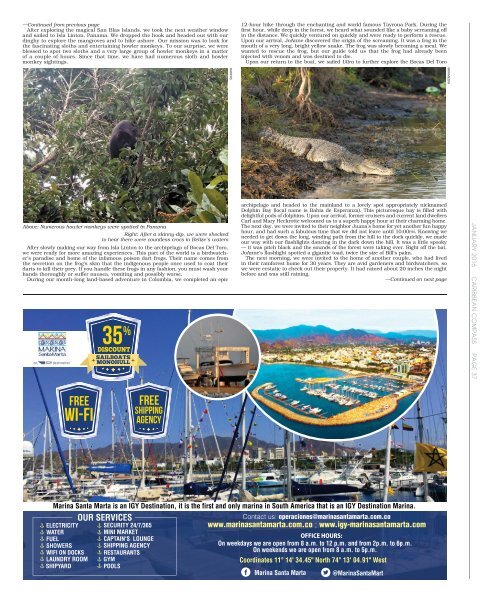Caribbean Compass Yachting Magazine January 2016
Welcome to Caribbean Compass, the most widely-read boating publication in the Caribbean! THE MOST NEWS YOU CAN USE - feature articles on cruising destinations, regattas, environment, events...
Welcome to Caribbean Compass, the most widely-read boating publication in the Caribbean! THE MOST NEWS YOU CAN USE - feature articles on cruising destinations, regattas, environment, events...
Create successful ePaper yourself
Turn your PDF publications into a flip-book with our unique Google optimized e-Paper software.
— Continued from previous page<br />
After exploring the magical San Blas Islands, we took the next weather window<br />
and sailed to Isla Linton, Panama. We dropped the hook and headed out with our<br />
dinghy to explore the mangroves and to hike ashore. Our mission was to look for<br />
the fascinating sloths and entertaining howler monkeys. To our surprise, we were<br />
blessed to spot two sloths and a very large group of howler monkeys in a matter<br />
of a couple of hours. Since that time, we have had numerous sloth and howler<br />
monkey sightings.<br />
12-hour hike through the enchanting and world famous Tayrona Park. During the<br />
first hour, while deep in the forest, we heard what sounded like a baby screaming off<br />
in the distance. We quickly ventured on quickly and were ready to perform a rescue.<br />
Upon our arrival, JoAnne discovered the origin of the screaming. It was a frog in the<br />
mouth of a very long, bright yellow snake. The frog was slowly becoming a meal. We<br />
wanted to rescue the frog, but our guide told us that the frog had already been<br />
injected with venom and was destined to die.<br />
Upon our return to the boat, we sailed Ultra to further explore the Bocas Del Toro<br />
WIKIMEDIA<br />
HARRIS<br />
Above: Numerous howler monkeys were spotted in Panama<br />
Right: After a skinny-dip, we were shocked<br />
to hear there were countless crocs in Belize’s waters<br />
After slowly making our way from Isla Linton to the archipelago of Bocas Del Toro,<br />
we were ready for more amazing experiences. This part of the world is a birdwatcher’s<br />
paradise and home of the infamous poison dart frogs. Their name comes from<br />
the secretion on the frog’s skin that the indigenous people once used to coat their<br />
darts to kill their prey. If you handle these frogs in any fashion, you must wash your<br />
hands thoroughly or suffer nausea, vomiting and possibly worse.<br />
During our month-long land-based adventure in Colombia, we completed an epic<br />
archipelago and headed to the mainland to a lovely spot appropriately nicknamed<br />
Dolphin Bay (local name is Bahia de Esperanza). This picturesque bay is filled with<br />
delightful pods of dolphins. Upon our arrival, former cruisers and current land dwellers<br />
Carl and Mary Heckrotte welcomed us to a superb happy hour at their charming home.<br />
The next day, we were invited to their neighbor Juana’s home for yet another fun happy<br />
hour, and had such a fabulous time that we did not leave until 10:00PM. Knowing we<br />
needed to get down the long, winding path from the hill to the dock quickly, we made<br />
our way with our flashlights dancing in the dark down the hill. It was a little spooky<br />
— it was pitch black and the sounds of the forest were taking over. Right off the bat,<br />
JoAnne’s flashlight spotted a gigantic toad, twice the size of Bill’s palm.<br />
The next morning, we were invited to the home of another couple, who had lived<br />
in their rainforest home for 30 years. They are avid gardeners and birdwatchers, so<br />
we were ecstatic to check out their property. It had rained about 20 inches the night<br />
before and was still raining.<br />
—Continued on next page<br />
JANUARY <strong>2016</strong> CARIBBEAN COMPASS PAGE 37


















